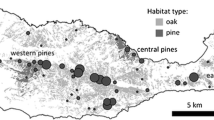Abstract
The scope of this paper can be clarified by means of a well-known phenomenon that is usually called ‘industrial melanism’: the fact that the melanic form of the peppered moth became dominant in industrial areas in England in the second half of the nineteenth century. Such changes in relative phenotype frequencies are important explananda for population biologists. Apart from trying to explain such changes over time, population biologists also often try to explain differences between populations, e.g. why yellow shell colour is dominant in certain colonies of land snails and almost absent in other colonies. The causal explanations that are given to address such explananda are the objects of analysis in this paper. Our primary aim is to explicate their structure: we want to capture the typical ingredients of causal explanations in population biology, and their organisation. Based on this explication, we discuss how natural selection fits into recent mechanical philosophy of science, and engage in the debate on the nature of evolutionary theory.
Similar content being viewed by others
Notes
One reason for this is pragmatic: one cannot discuss both types in one paper. Our choice for causal explanation as topic of this paper is related to a broader research interest, which is comparing causal explanations in population biology with causal explanations in the social sciences.
The moths could have been hunted by other visually oriented predators, but that was not the case.
Note that the use of models creates a controlled setting, because it excludes factors such as smell and escaping from predators (all attempts result in bite marks on the models). However, in natural experiments control can be incomplete, which makes causal inference more challenging and susceptible to error.
We thank one of the referees for pointing this out to us.
However, decomposition into entities is required. This is why Ioannidis and Psillos (2017) say this definition is ‘not truly minimalistic’. Their concept of mechanism as causal pathways does not require decomposition. Hence all mechanisms in the sense of Glennan are causal pathways (as conceived by Ioannidis & Psillos) but not vice versa.
References
Barrett R, Schluter D (2008) Adaptation from standing genetic variation. Trends Ecol Evol 23:38–44
Barros B (2008) Natural selection as a mechanism. Philos Sci 75:306–322
Bourrat P (2018) Natural selection and drift as individual level causes of evolution. Acta Biotheor 66:159–176
Craver C (2007) Explaining the brain. Clarendon Press, Oxford
Dice L (1940) Ecologic and genetic variability within species of peromyscuse. Am Nat 74:212–221
Ehrlich P, Holm R (1963) The process of evolution. McGraw-Hill Book Company, New York
Fletcher H, Hickey I (2013) BIOS instant notes in genetics, 4th edn. Garland Science, London, New York
Glennan S (1997) Probable causes and the distinction between subjective and objective chance. Noûs 31:496–519
Glennan S (2017) The new mechanical philosophy. Oxford University Press, New York
Grant V (1985) The evolutionary process—a critical review of evolutionary theory. Columbia University Press, New York
Humphreys P (1989) The chances of explanation: causal explanation in the social, medical, and physical sciences. Princeton University Press, Princeto
Illari P, Williamson J (2010) Function and organization: comparing the mechanisms of protein synthesis and natural selection. Stud Hist Philos Biol Biomed Sci 41:279–291
Ioannidis S, Psillos S (2017) In defense of methodological mechanism: the case of apoptosis. Axiomathes 27:601–619
Keeton W, Gould J (1986) Biological science, 4th edn. W.W.Norton & Co, New York, London
Kuhlman M, Glennan S (2014) On the relation between quantum mechanical and neo-mechanistic ontologies and explanatory strategies. Eur J Philos Sci 4:337–359
Machamer P, Darden L, Craver C (2000) Thinking about mechanisms. Philos Sci 67:1–25
Millstein R (2006) Natural selection as a population level causal process. Brit J Philos Sci 57:627–653
Otsuka J (2016) A critical review of the statisticalist debate. Biol Philos 31:459–482
Sandoval C (1994) Differential visual predation on morphs of Timema Cristinae (Phasmatodeae: Timemidae) and its consequences for host range. Biol J Linnean Soc 52:341–356
Seeley R (1986) Intense natural selection caused a rapid morphological transition in a living marine snail. Proc Natl Acad Sci 83:6897–6901
Skipper R, Millstein R (2005) Thinking about evolutionary mechanisms: natural selection. Stud Hist Philos Biol Biomed Sci 36:327–347
Sober E (1983) Equilibrium explanation. Philos Stud 43:201–210
Sober E (1984) The nature of selection. Evolutionary theory in philosophical focus. MIT Press, Cambridge
Steel D (2004) Social mechanisms and causal inference. Philos Soc Sci 34:55–57
Steel D (2008) Across the boundaries. Extrapolation in biology and social science. Oxford University Press, New York
Sumner F (1917) The role of isolation in the formation of a narrowly localized race of deer-mice (Peromyscus). Am Nat 51:173–185
Sumner F (1926) An analysis of geographic variation in mice of the Peromyscus Polionotus group from Florida and Alabama. J Mammal 7:149–184
Vignieri S, Larson J, Hoekstra H (2010) The selective advantage of crypsis in mice. Evolution 64:2153–2158
Woodward J (2003) Making things happen. Oxford University Press, Oxford
Author information
Authors and Affiliations
Corresponding author
Additional information
Publisher's Note
Springer Nature remains neutral with regard to jurisdictional claims in published maps and institutional affiliations.
Rights and permissions
About this article
Cite this article
Weber, E., Degeyter, R. The Structure of Causal Explanations in Population Biology. Acta Biotheor 69, 449–476 (2021). https://doi.org/10.1007/s10441-020-09405-9
Received:
Accepted:
Published:
Issue Date:
DOI: https://doi.org/10.1007/s10441-020-09405-9



